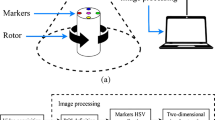Abstract
The thermally induced error is a critical element in the total errors for the robotic visual inspection system during its long-term operation. This paper investigates the thermal behavior of the robotic visual inspection system and proposes a real-time thermal error compensation method. Based on the fixed-point constraint, an error calibration model is derived by associating the thermally induced parameter errors with the deviations in the measured coordinates of the fixed reference point during the robot warm up and cool down. A joint-by-joint test is performed to investigate the link parameters that change significantly with respect to temperature variations. Standard spheres are adopted as the calibration targets, and optimum projected angles for sphere center measurement by visual sensor are obtained based on theoretical analysis and experimental data. Contrary to most other works, the method needs no exact knowledge of the temperature sensors and is well suited for online dynamic thermal error compensation for the robotic visual inspection system. Verification experiment is carried out on a car-body assembly line, and results show that the max/mean residual error for the tested points has been reduced from 0.441/0.195 to 0.136/0.078 mm with the significant parameters calibrated.
Similar content being viewed by others
References
Brosed F, Santolaria J, Aguilar J, Guillom AD (2012) Laser triangulation sensor and six axes anthropomorphic robot manipulator modelling for the measurement of complex geometry products Robot. Comput Integr Manuf 28:660–671
Larsson S, Kjellander J (2006) Motion control and data capturing for laser scanning with an industrial robot. Robot Auton Syst 54:453–460
Xie SQ, Cheng D, Wong S, Haemmerle E (2008) Three-dimensional object recognition system for enhancing the intelligence of a KUKA robot. Int J Adv Manuf Technol 38(7–8):822–839
Paoli A, Razionale AV (2012) Large yacht hull measurement by integrating optical scanning with mechanical tracking-based methodologies Robot. Comput Integr Manuf 28:592–601
Liu CJ, Yang XY, Zhu JG, Ye SH (2006) Flexible coordinate measurement system based on industrial robot for car body-in-white. J Optoelectron Laser 17:207–210
Conrad KL, Shiakolas PS, Yih T (2000) Robotic calibration issues: Accuracy, repeatability and calibration Proc. 8th Medit. Conf. on Control and Automation (MED2000). pp 17-19
Roth Z, Mooring B, Ravani B (1987) An overview of robot calibration. IEEE J Robot Autom 3:377–385
Ha IC (2008) Kinematic parameter calibration method for industrial robot manipulator using the relative position. J Mech Sci Technol 22:1084–1090
Bai Y (2007) On the comparison of model-based and modeless robotic calibration based on a fuzzy interpolation method. Int J Adv Manuf Technol 31(11–12):1243–1250
Gatti G, Danieli G (2008) A practical approach to compensate for geometric errors in measuring arms: Application to a six-degree-of-freedom kinematic structure Measu. Sci Technol 19:015107
Drouet P, Dubowsky S, Zeghloul S, Mavroidis C (2002) Compensation of geometric and elastic errors in large manipulators with an application to a high accuracy medical system. Robotica 20:341–352
Aoyagi S, Kohama A, Nakata Y, Hayano Y, Suzuki M (2010) Improvement of robot accuracy by calibrating kinematic model using a laser tracking system-compensation of non-geometric errors using neural networks and selection of optimal measuring points using genetic algorithm IEEE/RSJ Int. Conf. on Intelligent Robots and Systems (IROS). pp 5660-5665
Hollerbach JM (1989) A survey of kinematic calibration. In: Khatib O, Craig JJ, Lozano T (eds) The robotics review, 1st edn. MIT Press, Cambridge, pp 207–242
Mooring BW, Roth ZS, Driels MR (1991) Fundamentals of manipulator calibration. Wiley, New York
Driels MR, Swayze LW, Potter LS (1993) Full-pose calibration of a robot manipulator using a coordinate-measuring machine. Int J Adv Manuf Technol 8(1):34–41
Santolaria J, Brau A, Velzquez J, Aguilar J (2010) A self-centering active probing technique for kinematic parameter identification and verification of articulated arm coordinate measuring machines. Meas Sci Technol 21:055101–055111
Yin S, Ren Y, Zhu J, Yang S, Ye S (2013) A vision-based self-calibration method for robotic visual inspection systems. Sensors 13:16565–16582
Jang JH, Kim SH, Kwak YK (2001) Calibration of geometric and non-geometric errors of an industrial robot. Robotica 19:311–321
Nubiola A, Bonev IA (2012) Absolute calibration of an ABB IRB 1600 robot using a laser tracker Robot. Comput Integr Manuf 29:236–245
Slamani M, Nubiola A, Bonev IA (2012) Modeling and assessment of the backlash error of an industrial robot. Robotica 30:1167–1175
Eastwood S, Webb P (2009) Compensation of thermal deformation of a hybrid parallel kinematic machine. Robot Comput Integr Manuf 25:81–90
Santolaria J, Yag EJA, Jimnez R, Aguilar JJ (2009) Calibration-based thermal error model for articulated arm coordinate measuring machines. Precis Eng 33:476–485
Heisel U, Richter F, Wurst KH (1997) Thermal behaviour of industrial robots and possibilities for error compensation. CIRP Ann Manuf Technol 46:283–286
Poonyapak P, Hayes MJD (2006) Towards a Predictive Model for Temperature-Induced Deformation of an Industrial Robot Proc of EuCoMeS the first European Conf. on Mechanism Science, Obergurgl (Austria)
Gong C, Yuan J, Ni J (2000) Nongeometric error identification and compensation for robotic system by inverse calibration Int. J Mach Tools Manuf 40:2119–2137
Denavit J, Hartenberg RS (1955) A kinematic notation for lower-pair mechanisms based on matrices. ASME J Appl Mech 22:215–221
Paul RP (1981) Robot manipulators: mathematics, programming, and control: the computer control of robot manipulators
Anchini R, Beraldin J, Liguori C (2007) Subpixel location of discrete target images in close-range camera calibration: a novel approach Electronic Imaging 2007, International Society for Optics and Photonics. pp 649110-649118
Feng HY, Liu Y, Xi F (2001) Analysis of digitizing errors of a laser scanning system. Precis Eng 25:185–191
Author information
Authors and Affiliations
Corresponding author
Rights and permissions
About this article
Cite this article
Yin, S., Guo, Y., Ren, Y. et al. Real-time thermal error compensation method for robotic visual inspection system. Int J Adv Manuf Technol 75, 933–946 (2014). https://doi.org/10.1007/s00170-014-6196-6
Received:
Accepted:
Published:
Issue Date:
DOI: https://doi.org/10.1007/s00170-014-6196-6




